Campaign Speech: Identifying and Solving Drug and Alcohol Abuse
VerifiedAdded on 2020/05/16
|6
|1352
|818
Project
AI Summary
This campaign speech addresses the critical issue of alcohol and drug abuse, particularly targeting teenagers. It begins by highlighting the detrimental effects of substance abuse on various aspects of life and emphasizes the importance of early identification. The speech provides insights into the symptoms of alcohol and drug abuse, including behavioral changes and physical signs, to help in timely detection. It then discusses innovative methods for identifying and solving the problem, such as the use of screening tools like AUDIT and CRAFFT, and the integration of these tools into electronic health records. The speech also explores effective prevention strategies, including school-based interventions that provide cognitive behavioral training and motivational enhancement. Furthermore, it advocates for community-based strategies to address parental influence and promote protective factors. Overall, the campaign speech emphasizes the need for a multi-faceted approach, combining technological advancements, personalized interventions, and community involvement to reduce the harmful consequences of alcohol and drug abuse.
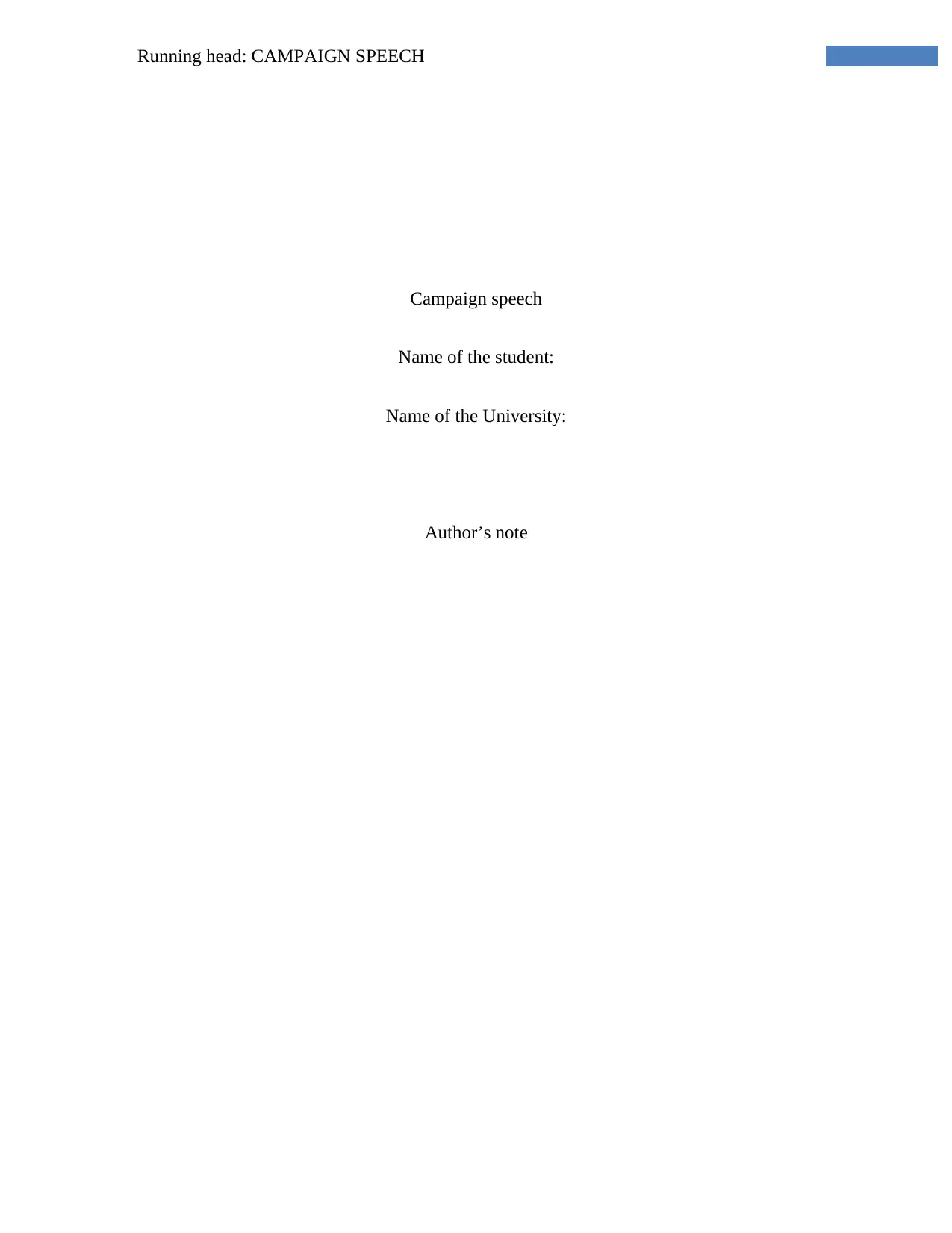
Running head: CAMPAIGN SPEECH
Campaign speech
Name of the student:
Name of the University:
Author’s note
Campaign speech
Name of the student:
Name of the University:
Author’s note
Paraphrase This Document
Need a fresh take? Get an instant paraphrase of this document with our AI Paraphraser
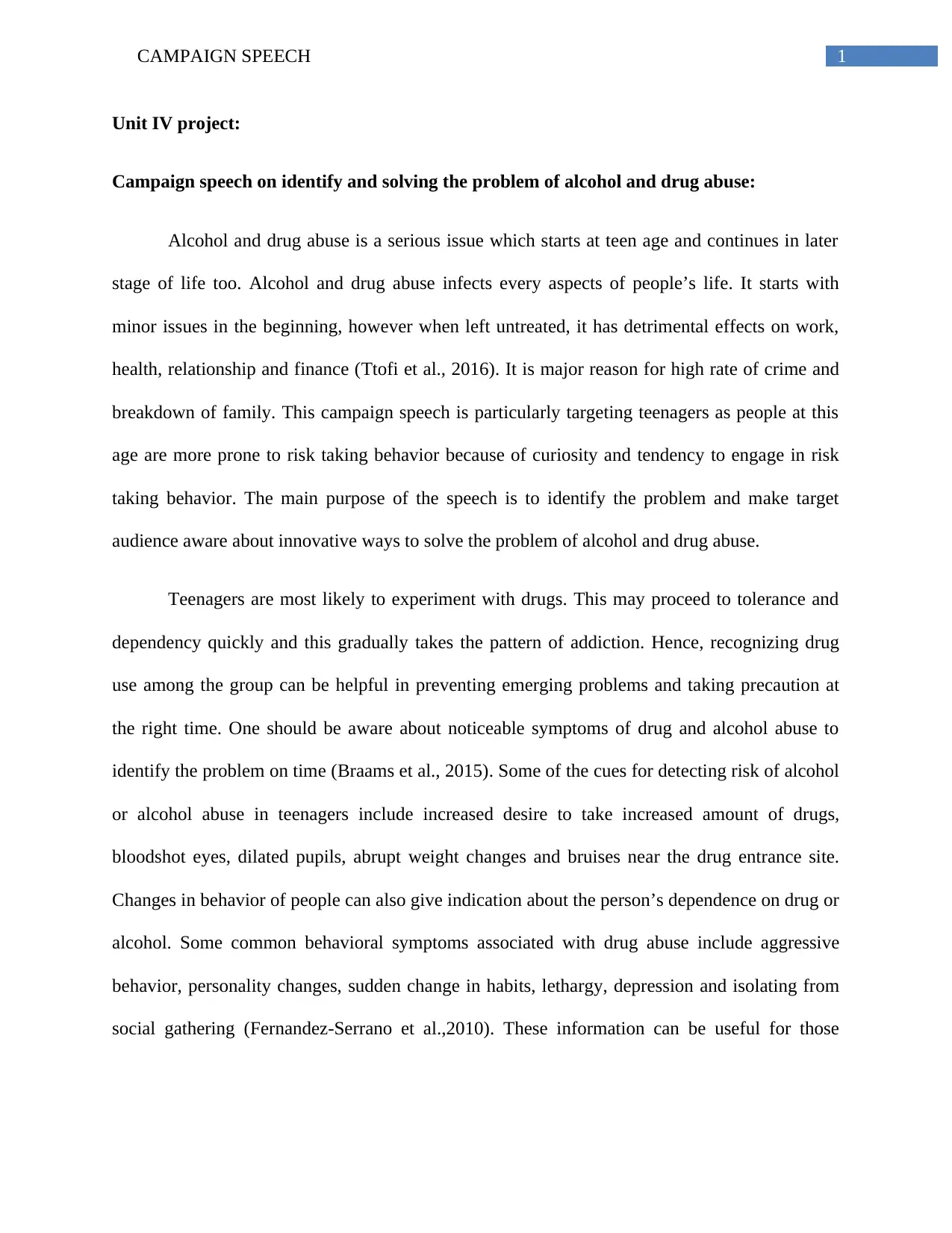
1CAMPAIGN SPEECH
Unit IV project:
Campaign speech on identify and solving the problem of alcohol and drug abuse:
Alcohol and drug abuse is a serious issue which starts at teen age and continues in later
stage of life too. Alcohol and drug abuse infects every aspects of people’s life. It starts with
minor issues in the beginning, however when left untreated, it has detrimental effects on work,
health, relationship and finance (Ttofi et al., 2016). It is major reason for high rate of crime and
breakdown of family. This campaign speech is particularly targeting teenagers as people at this
age are more prone to risk taking behavior because of curiosity and tendency to engage in risk
taking behavior. The main purpose of the speech is to identify the problem and make target
audience aware about innovative ways to solve the problem of alcohol and drug abuse.
Teenagers are most likely to experiment with drugs. This may proceed to tolerance and
dependency quickly and this gradually takes the pattern of addiction. Hence, recognizing drug
use among the group can be helpful in preventing emerging problems and taking precaution at
the right time. One should be aware about noticeable symptoms of drug and alcohol abuse to
identify the problem on time (Braams et al., 2015). Some of the cues for detecting risk of alcohol
or alcohol abuse in teenagers include increased desire to take increased amount of drugs,
bloodshot eyes, dilated pupils, abrupt weight changes and bruises near the drug entrance site.
Changes in behavior of people can also give indication about the person’s dependence on drug or
alcohol. Some common behavioral symptoms associated with drug abuse include aggressive
behavior, personality changes, sudden change in habits, lethargy, depression and isolating from
social gathering (Fernandez-Serrano et al.,2010). These information can be useful for those
Unit IV project:
Campaign speech on identify and solving the problem of alcohol and drug abuse:
Alcohol and drug abuse is a serious issue which starts at teen age and continues in later
stage of life too. Alcohol and drug abuse infects every aspects of people’s life. It starts with
minor issues in the beginning, however when left untreated, it has detrimental effects on work,
health, relationship and finance (Ttofi et al., 2016). It is major reason for high rate of crime and
breakdown of family. This campaign speech is particularly targeting teenagers as people at this
age are more prone to risk taking behavior because of curiosity and tendency to engage in risk
taking behavior. The main purpose of the speech is to identify the problem and make target
audience aware about innovative ways to solve the problem of alcohol and drug abuse.
Teenagers are most likely to experiment with drugs. This may proceed to tolerance and
dependency quickly and this gradually takes the pattern of addiction. Hence, recognizing drug
use among the group can be helpful in preventing emerging problems and taking precaution at
the right time. One should be aware about noticeable symptoms of drug and alcohol abuse to
identify the problem on time (Braams et al., 2015). Some of the cues for detecting risk of alcohol
or alcohol abuse in teenagers include increased desire to take increased amount of drugs,
bloodshot eyes, dilated pupils, abrupt weight changes and bruises near the drug entrance site.
Changes in behavior of people can also give indication about the person’s dependence on drug or
alcohol. Some common behavioral symptoms associated with drug abuse include aggressive
behavior, personality changes, sudden change in habits, lethargy, depression and isolating from
social gathering (Fernandez-Serrano et al.,2010). These information can be useful for those
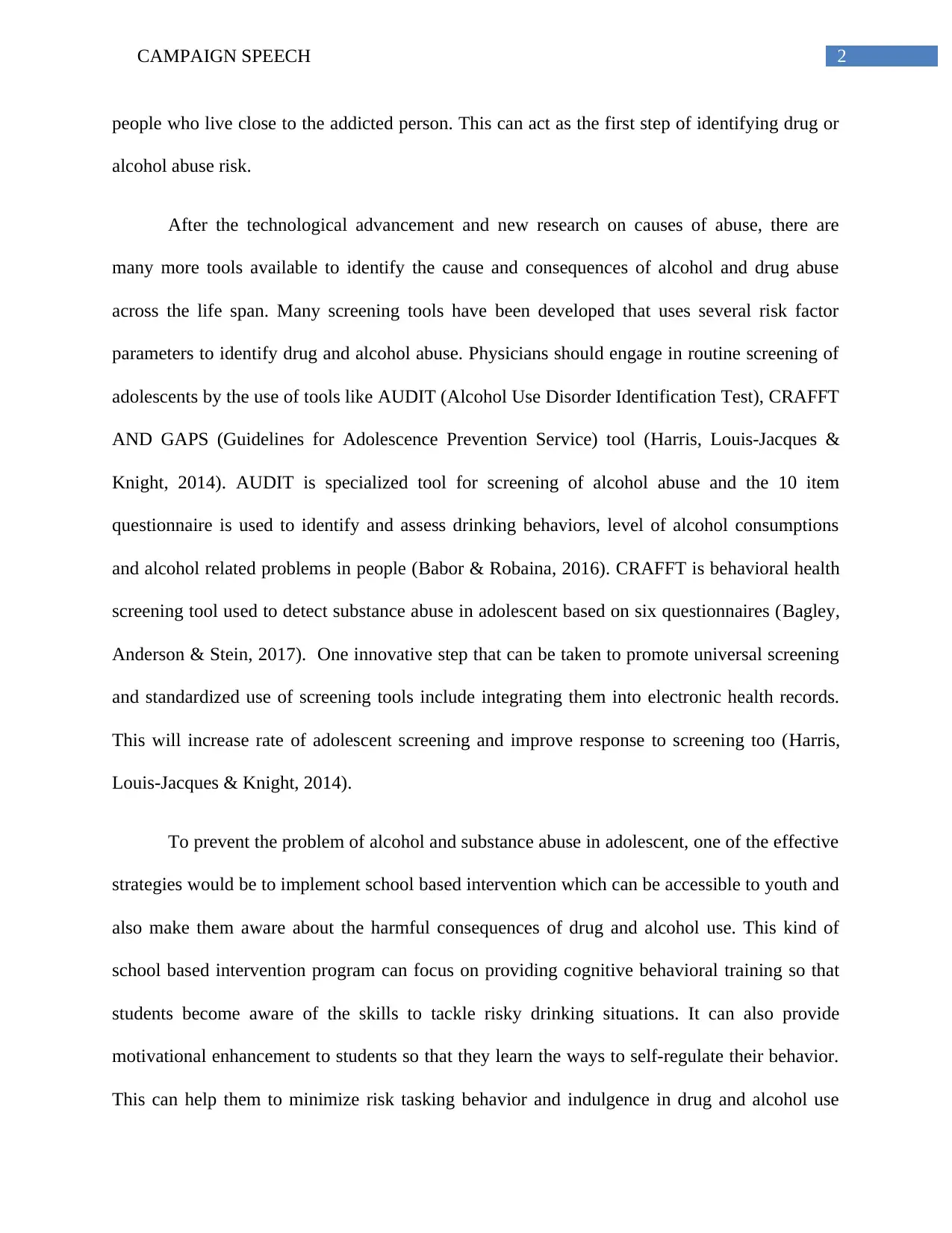
2CAMPAIGN SPEECH
people who live close to the addicted person. This can act as the first step of identifying drug or
alcohol abuse risk.
After the technological advancement and new research on causes of abuse, there are
many more tools available to identify the cause and consequences of alcohol and drug abuse
across the life span. Many screening tools have been developed that uses several risk factor
parameters to identify drug and alcohol abuse. Physicians should engage in routine screening of
adolescents by the use of tools like AUDIT (Alcohol Use Disorder Identification Test), CRAFFT
AND GAPS (Guidelines for Adolescence Prevention Service) tool (Harris, Louis-Jacques &
Knight, 2014). AUDIT is specialized tool for screening of alcohol abuse and the 10 item
questionnaire is used to identify and assess drinking behaviors, level of alcohol consumptions
and alcohol related problems in people (Babor & Robaina, 2016). CRAFFT is behavioral health
screening tool used to detect substance abuse in adolescent based on six questionnaires (Bagley,
Anderson & Stein, 2017). One innovative step that can be taken to promote universal screening
and standardized use of screening tools include integrating them into electronic health records.
This will increase rate of adolescent screening and improve response to screening too (Harris,
Louis-Jacques & Knight, 2014).
To prevent the problem of alcohol and substance abuse in adolescent, one of the effective
strategies would be to implement school based intervention which can be accessible to youth and
also make them aware about the harmful consequences of drug and alcohol use. This kind of
school based intervention program can focus on providing cognitive behavioral training so that
students become aware of the skills to tackle risky drinking situations. It can also provide
motivational enhancement to students so that they learn the ways to self-regulate their behavior.
This can help them to minimize risk tasking behavior and indulgence in drug and alcohol use
people who live close to the addicted person. This can act as the first step of identifying drug or
alcohol abuse risk.
After the technological advancement and new research on causes of abuse, there are
many more tools available to identify the cause and consequences of alcohol and drug abuse
across the life span. Many screening tools have been developed that uses several risk factor
parameters to identify drug and alcohol abuse. Physicians should engage in routine screening of
adolescents by the use of tools like AUDIT (Alcohol Use Disorder Identification Test), CRAFFT
AND GAPS (Guidelines for Adolescence Prevention Service) tool (Harris, Louis-Jacques &
Knight, 2014). AUDIT is specialized tool for screening of alcohol abuse and the 10 item
questionnaire is used to identify and assess drinking behaviors, level of alcohol consumptions
and alcohol related problems in people (Babor & Robaina, 2016). CRAFFT is behavioral health
screening tool used to detect substance abuse in adolescent based on six questionnaires (Bagley,
Anderson & Stein, 2017). One innovative step that can be taken to promote universal screening
and standardized use of screening tools include integrating them into electronic health records.
This will increase rate of adolescent screening and improve response to screening too (Harris,
Louis-Jacques & Knight, 2014).
To prevent the problem of alcohol and substance abuse in adolescent, one of the effective
strategies would be to implement school based intervention which can be accessible to youth and
also make them aware about the harmful consequences of drug and alcohol use. This kind of
school based intervention program can focus on providing cognitive behavioral training so that
students become aware of the skills to tackle risky drinking situations. It can also provide
motivational enhancement to students so that they learn the ways to self-regulate their behavior.
This can help them to minimize risk tasking behavior and indulgence in drug and alcohol use
⊘ This is a preview!⊘
Do you want full access?
Subscribe today to unlock all pages.

Trusted by 1+ million students worldwide
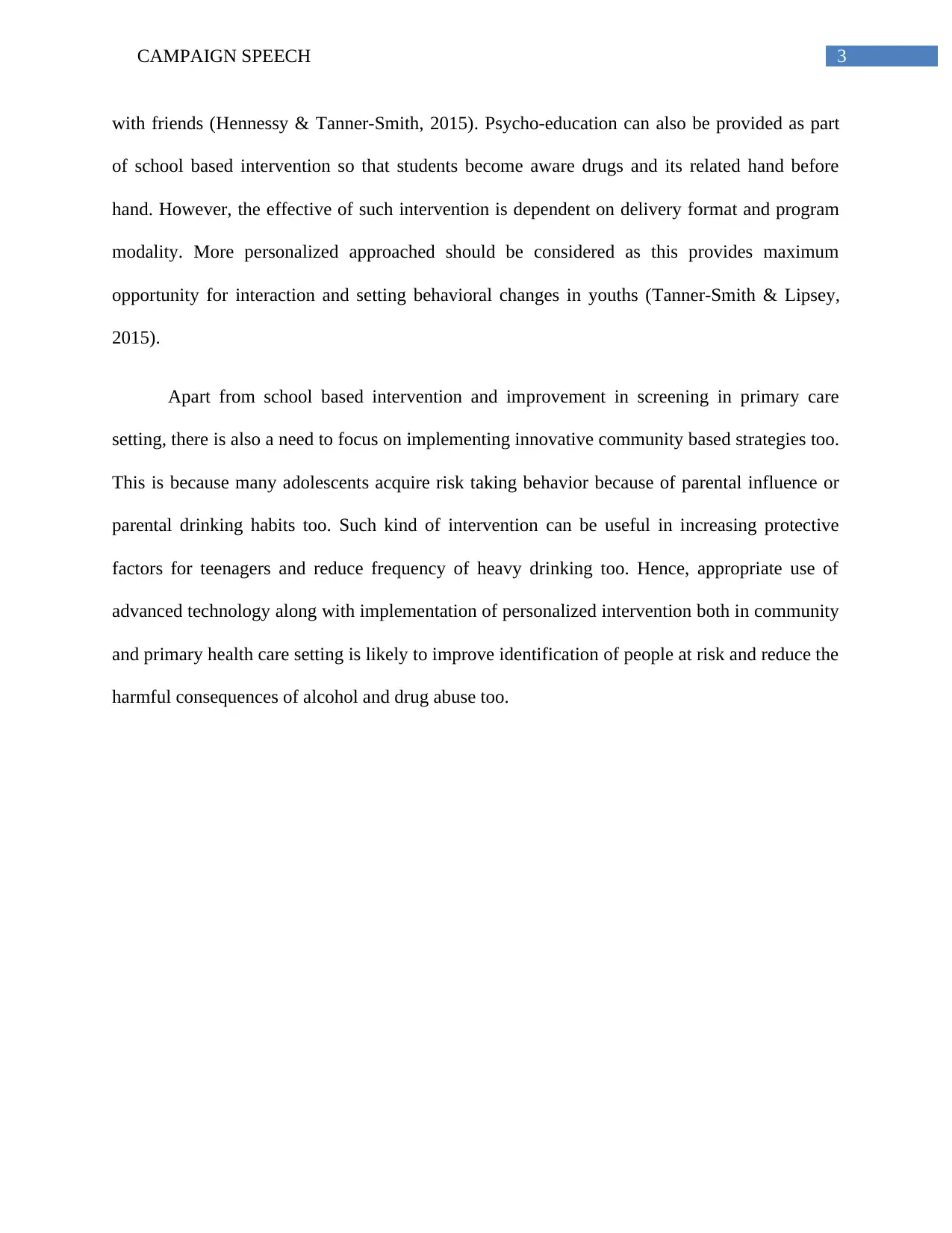
3CAMPAIGN SPEECH
with friends (Hennessy & Tanner-Smith, 2015). Psycho-education can also be provided as part
of school based intervention so that students become aware drugs and its related hand before
hand. However, the effective of such intervention is dependent on delivery format and program
modality. More personalized approached should be considered as this provides maximum
opportunity for interaction and setting behavioral changes in youths (Tanner-Smith & Lipsey,
2015).
Apart from school based intervention and improvement in screening in primary care
setting, there is also a need to focus on implementing innovative community based strategies too.
This is because many adolescents acquire risk taking behavior because of parental influence or
parental drinking habits too. Such kind of intervention can be useful in increasing protective
factors for teenagers and reduce frequency of heavy drinking too. Hence, appropriate use of
advanced technology along with implementation of personalized intervention both in community
and primary health care setting is likely to improve identification of people at risk and reduce the
harmful consequences of alcohol and drug abuse too.
with friends (Hennessy & Tanner-Smith, 2015). Psycho-education can also be provided as part
of school based intervention so that students become aware drugs and its related hand before
hand. However, the effective of such intervention is dependent on delivery format and program
modality. More personalized approached should be considered as this provides maximum
opportunity for interaction and setting behavioral changes in youths (Tanner-Smith & Lipsey,
2015).
Apart from school based intervention and improvement in screening in primary care
setting, there is also a need to focus on implementing innovative community based strategies too.
This is because many adolescents acquire risk taking behavior because of parental influence or
parental drinking habits too. Such kind of intervention can be useful in increasing protective
factors for teenagers and reduce frequency of heavy drinking too. Hence, appropriate use of
advanced technology along with implementation of personalized intervention both in community
and primary health care setting is likely to improve identification of people at risk and reduce the
harmful consequences of alcohol and drug abuse too.
Paraphrase This Document
Need a fresh take? Get an instant paraphrase of this document with our AI Paraphraser
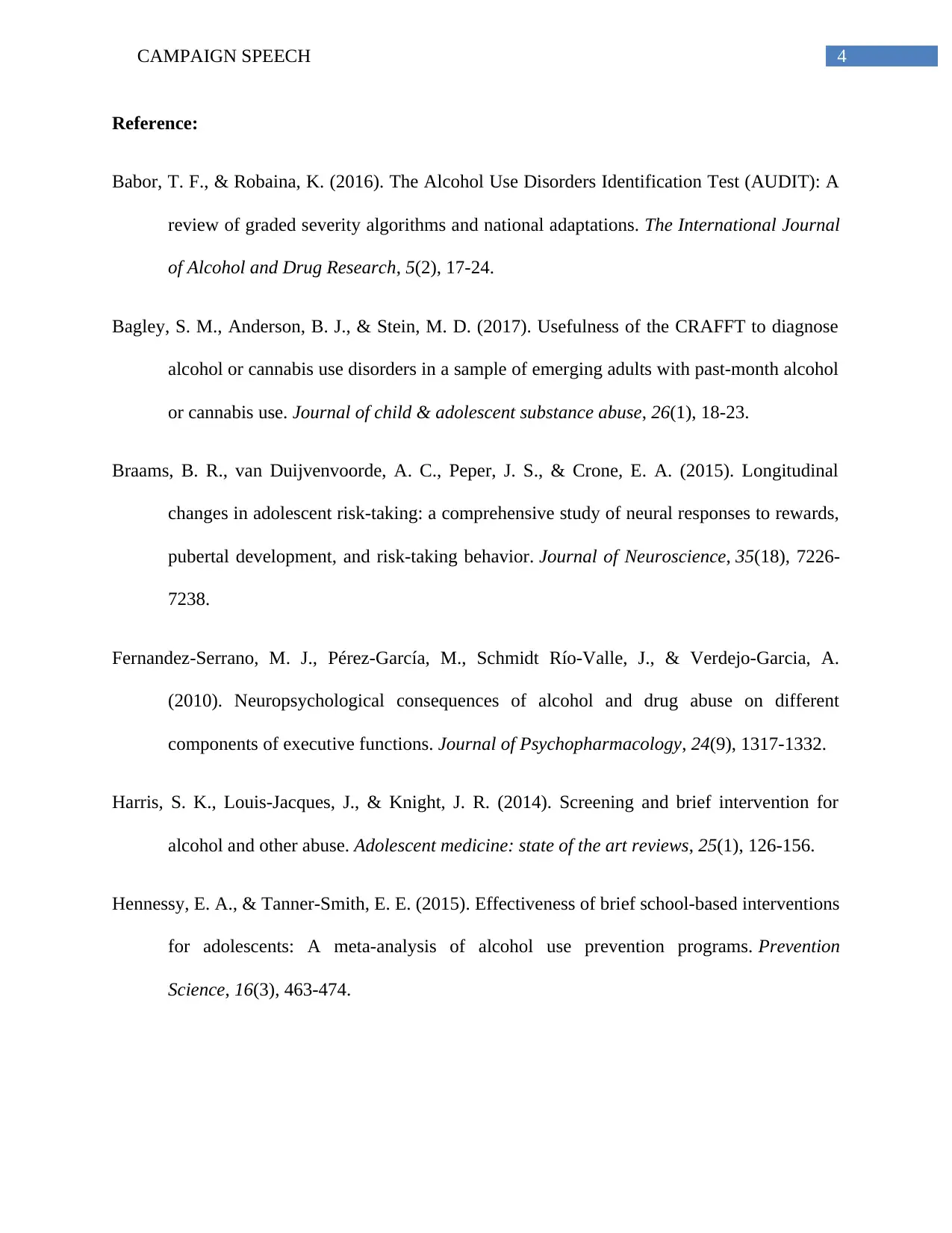
4CAMPAIGN SPEECH
Reference:
Babor, T. F., & Robaina, K. (2016). The Alcohol Use Disorders Identification Test (AUDIT): A
review of graded severity algorithms and national adaptations. The International Journal
of Alcohol and Drug Research, 5(2), 17-24.
Bagley, S. M., Anderson, B. J., & Stein, M. D. (2017). Usefulness of the CRAFFT to diagnose
alcohol or cannabis use disorders in a sample of emerging adults with past-month alcohol
or cannabis use. Journal of child & adolescent substance abuse, 26(1), 18-23.
Braams, B. R., van Duijvenvoorde, A. C., Peper, J. S., & Crone, E. A. (2015). Longitudinal
changes in adolescent risk-taking: a comprehensive study of neural responses to rewards,
pubertal development, and risk-taking behavior. Journal of Neuroscience, 35(18), 7226-
7238.
Fernandez-Serrano, M. J., Pérez-García, M., Schmidt Río-Valle, J., & Verdejo-Garcia, A.
(2010). Neuropsychological consequences of alcohol and drug abuse on different
components of executive functions. Journal of Psychopharmacology, 24(9), 1317-1332.
Harris, S. K., Louis-Jacques, J., & Knight, J. R. (2014). Screening and brief intervention for
alcohol and other abuse. Adolescent medicine: state of the art reviews, 25(1), 126-156.
Hennessy, E. A., & Tanner-Smith, E. E. (2015). Effectiveness of brief school-based interventions
for adolescents: A meta-analysis of alcohol use prevention programs. Prevention
Science, 16(3), 463-474.
Reference:
Babor, T. F., & Robaina, K. (2016). The Alcohol Use Disorders Identification Test (AUDIT): A
review of graded severity algorithms and national adaptations. The International Journal
of Alcohol and Drug Research, 5(2), 17-24.
Bagley, S. M., Anderson, B. J., & Stein, M. D. (2017). Usefulness of the CRAFFT to diagnose
alcohol or cannabis use disorders in a sample of emerging adults with past-month alcohol
or cannabis use. Journal of child & adolescent substance abuse, 26(1), 18-23.
Braams, B. R., van Duijvenvoorde, A. C., Peper, J. S., & Crone, E. A. (2015). Longitudinal
changes in adolescent risk-taking: a comprehensive study of neural responses to rewards,
pubertal development, and risk-taking behavior. Journal of Neuroscience, 35(18), 7226-
7238.
Fernandez-Serrano, M. J., Pérez-García, M., Schmidt Río-Valle, J., & Verdejo-Garcia, A.
(2010). Neuropsychological consequences of alcohol and drug abuse on different
components of executive functions. Journal of Psychopharmacology, 24(9), 1317-1332.
Harris, S. K., Louis-Jacques, J., & Knight, J. R. (2014). Screening and brief intervention for
alcohol and other abuse. Adolescent medicine: state of the art reviews, 25(1), 126-156.
Hennessy, E. A., & Tanner-Smith, E. E. (2015). Effectiveness of brief school-based interventions
for adolescents: A meta-analysis of alcohol use prevention programs. Prevention
Science, 16(3), 463-474.
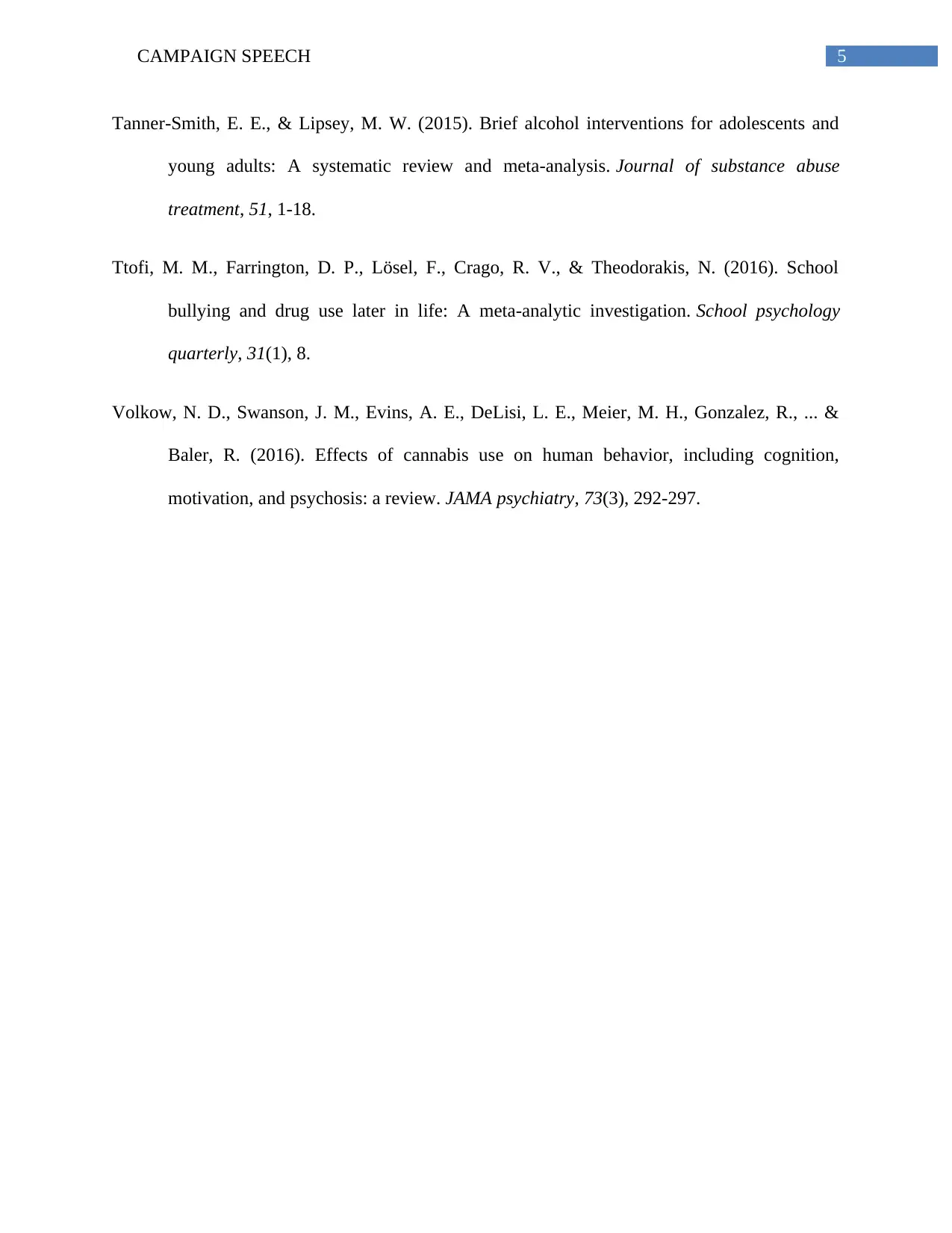
5CAMPAIGN SPEECH
Tanner-Smith, E. E., & Lipsey, M. W. (2015). Brief alcohol interventions for adolescents and
young adults: A systematic review and meta-analysis. Journal of substance abuse
treatment, 51, 1-18.
Ttofi, M. M., Farrington, D. P., Lösel, F., Crago, R. V., & Theodorakis, N. (2016). School
bullying and drug use later in life: A meta-analytic investigation. School psychology
quarterly, 31(1), 8.
Volkow, N. D., Swanson, J. M., Evins, A. E., DeLisi, L. E., Meier, M. H., Gonzalez, R., ... &
Baler, R. (2016). Effects of cannabis use on human behavior, including cognition,
motivation, and psychosis: a review. JAMA psychiatry, 73(3), 292-297.
Tanner-Smith, E. E., & Lipsey, M. W. (2015). Brief alcohol interventions for adolescents and
young adults: A systematic review and meta-analysis. Journal of substance abuse
treatment, 51, 1-18.
Ttofi, M. M., Farrington, D. P., Lösel, F., Crago, R. V., & Theodorakis, N. (2016). School
bullying and drug use later in life: A meta-analytic investigation. School psychology
quarterly, 31(1), 8.
Volkow, N. D., Swanson, J. M., Evins, A. E., DeLisi, L. E., Meier, M. H., Gonzalez, R., ... &
Baler, R. (2016). Effects of cannabis use on human behavior, including cognition,
motivation, and psychosis: a review. JAMA psychiatry, 73(3), 292-297.
⊘ This is a preview!⊘
Do you want full access?
Subscribe today to unlock all pages.

Trusted by 1+ million students worldwide
1 out of 6
Related Documents
Your All-in-One AI-Powered Toolkit for Academic Success.
+13062052269
info@desklib.com
Available 24*7 on WhatsApp / Email
![[object Object]](/_next/static/media/star-bottom.7253800d.svg)
Unlock your academic potential
Copyright © 2020–2026 A2Z Services. All Rights Reserved. Developed and managed by ZUCOL.





